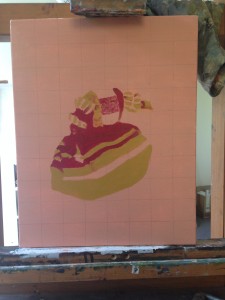|
 Over the summer I painted a Tudor dress with a girl in it. Over the summer I painted a Tudor dress with a girl in it.
Let me phrase that more appropriately. A client of mine took advantage of an offer and provided a picture to let me expand my portfolio. She pre-bought a couple of prints, with the proceeds going to a joint show I was putting on, and I painted something that I would get to keep. I had worked for the client before, and she knew my working style and was very happy to hand over many, many, pictures of her daughter. I chose a pose and drew it out in pencil to work out the tonal points and the colours. I also grounded a canvas, painting over the white gesso with a colour mixed from the two main paints I would be using, the red and the yellow. This would help tie everything together, and if I painted any part thinly it would show through without being in white. Crucially, it would also help me paint every area equally strongly. The dress was in two very strong colours which I would be painting, rather unusually, straight from the tube. They would be at maximum saturation in large areas, and anything that was too subtle in tone would be lost.
Faces tend to be subtle in tone, and the client’s daughter was pale. This was not instantly an easy picture.
 After my pencil drawing was complete and my canvas was dry, I started painting. The most important thing in my mind was to get the props right. At this point, I was still lacking in decent photographs of the child’s face, so I had a double reason to work on the dress, but for the most part I was just eager to get to it as it was drapery. I blocked out the solid colours to see how they would go together. The answer was that the clashed quite a lot. It was not a bad effect, but the two strong colours formed a very strong edge wherever they touched. They also clashed slightly with the background, but that was rather the effect of the background being the step in between, and I was not concerned about it. After my pencil drawing was complete and my canvas was dry, I started painting. The most important thing in my mind was to get the props right. At this point, I was still lacking in decent photographs of the child’s face, so I had a double reason to work on the dress, but for the most part I was just eager to get to it as it was drapery. I blocked out the solid colours to see how they would go together. The answer was that the clashed quite a lot. It was not a bad effect, but the two strong colours formed a very strong edge wherever they touched. They also clashed slightly with the background, but that was rather the effect of the background being the step in between, and I was not concerned about it.
I had to use the strong colours to do the basic blocking out, leaving me areas edged out in bright colour that would then have to be filled in in white. Rather than mix colours in with the drag of the brush, I left the solid shapes to be filled in later. As I was going to have to add at least one more layer to the drapery, this did not occur to me as a problem, although down the line I still found it hard to have white that was white enough.
|